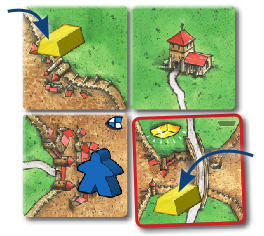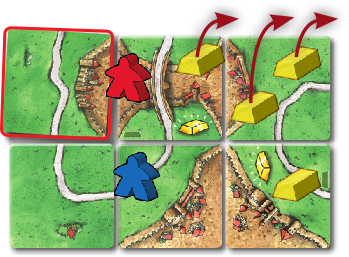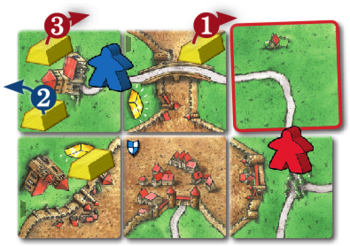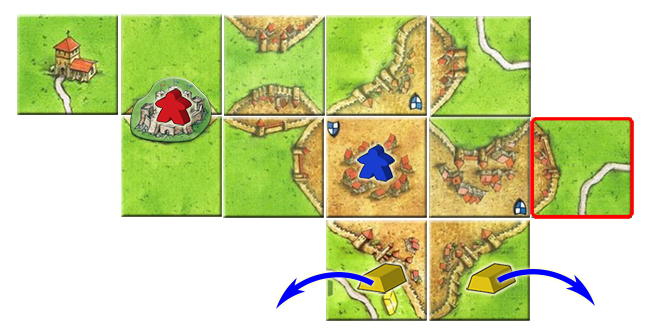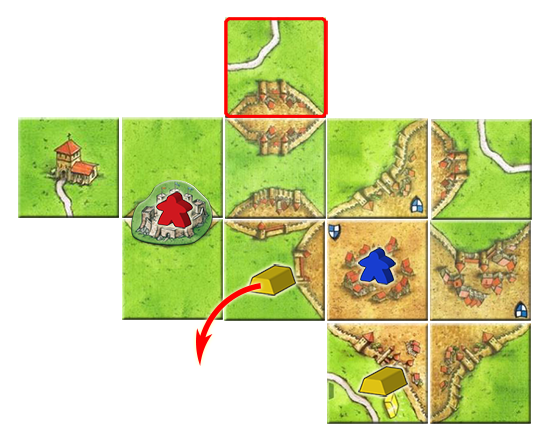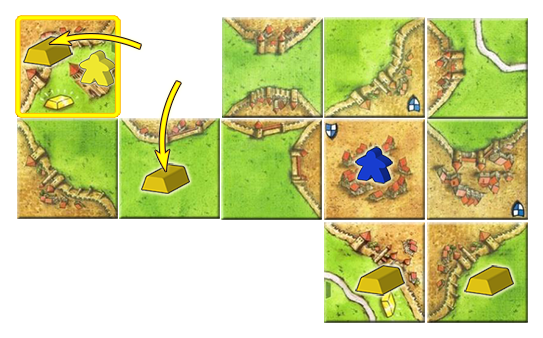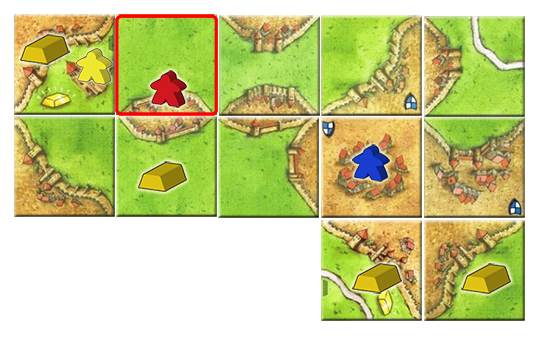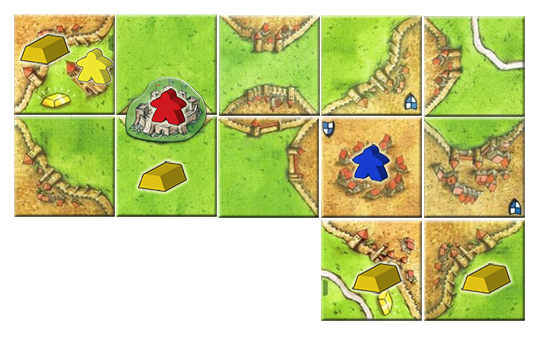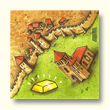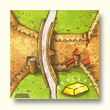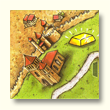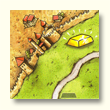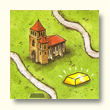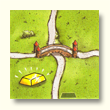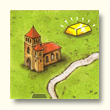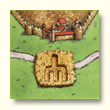Difference between revisions of "The Goldmines (1st edition)/ro"
(Created page with "::'''Exemplul 6: Explorarea evaluării unei mănăstiri suprapunându-se vecinătății unei cetăți''' <!-- Examples: Cloister 4A, 4B -->") |
(Created page with "::File:Goldmines_C1_Scoring_Castle_Example_0A.png|frame|none|'''Exemplul 1A:''' Jucătorul {{ColorRed|ROȘU}} finalizează orașul ocupat de jucătorul {{ColorBlue|ALBASTRU}}, ceea ce declanșează evaluarea cetății ocupate de jucătorul {{ColorRed|ROȘU}}. Ca jucător activ, jucătorul {{ColorRed|ROȘU}} ia primul un bulgăre de aur și apoi jucătorul {{ColorBlue|ALBASTRU}}. Și jucătorul {{ColorBlue|ALBASTRU}} era îndreptățit la bulgărele de aur luat de jucă...") |
||
| Line 168: | Line 168: | ||
::'''Exemplul 1: Explorarea unor secvențe variate''' <!-- Examples: Castle 0A, 0B, 0C --> | ::'''Exemplul 1: Explorarea unor secvențe variate''' <!-- Examples: Castle 0A, 0B, 0C --> | ||
::[[File:Goldmines_C1_Scoring_Castle_Example_0A.png|frame|none|''' | ::[[File:Goldmines_C1_Scoring_Castle_Example_0A.png|frame|none|'''Exemplul 1A:''' Jucătorul {{ColorRed|ROȘU}} finalizează orașul ocupat de jucătorul {{ColorBlue|ALBASTRU}}, ceea ce declanșează evaluarea cetății ocupate de jucătorul {{ColorRed|ROȘU}}. Ca jucător activ, jucătorul {{ColorRed|ROȘU}} ia primul un bulgăre de aur și apoi jucătorul {{ColorBlue|ALBASTRU}}. Și jucătorul {{ColorBlue|ALBASTRU}} era îndreptățit la bulgărele de aur luat de jucătorul {{ColorRed|ROȘU}} (plasat în vecinătatea cetății și de asemenea pe unul dintre cartonașele orașului controlat de jucătorul {{ColorBlue|ALBASTRU}}), dar era singura alegere a jucătorului {{ColorRed|ROȘU}} în acest caz. Prin urmare, jucătorul {{ColorBlue|ALBASTRU}} poate lua numai bulgărele de aur din partea de jos a orașului.]] | ||
::[[File:Goldmines_C1_Scoring_Castle_Example_0B.png|frame|none|'''Example 1B-1:''' {{ColorBlue|BLUE}} completes their city, which triggers the scoring of the castle occupied by {{ColorRed|RED}}. As the active player, {{ColorBlue|BLUE}} takes a gold piece first and then {{ColorRed|RED}}. {{ColorBlue|BLUE}} was also entitled to the gold piece taken by {{ColorRed|RED}} (placed in the castle vicinity and also on one tile of the city controlled by {{ColorBlue|BLUE}}), and it was {{ColorRed|RED}}'s only choice in this case, since {{ColorBlue|BLUE}} took the gold piece at the bottom of the city.]] | ::[[File:Goldmines_C1_Scoring_Castle_Example_0B.png|frame|none|'''Example 1B-1:''' {{ColorBlue|BLUE}} completes their city, which triggers the scoring of the castle occupied by {{ColorRed|RED}}. As the active player, {{ColorBlue|BLUE}} takes a gold piece first and then {{ColorRed|RED}}. {{ColorBlue|BLUE}} was also entitled to the gold piece taken by {{ColorRed|RED}} (placed in the castle vicinity and also on one tile of the city controlled by {{ColorBlue|BLUE}}), and it was {{ColorRed|RED}}'s only choice in this case, since {{ColorBlue|BLUE}} took the gold piece at the bottom of the city.]] | ||
Revision as of 21:41, 2 May 2024
 |
Citești regulile pentru acest design al cartonașelor. |
 | Citește următoarele reguli dacă cartonașele tale arată astfel. |  |
| Dacă cartonașele tale au un design diferit, atunci alege un joc din Spin-off-uri. |  |
AUR! Îi înnebunește pe toți! Toți încearcă să pună mâna pe acest metal prețios, chiar dacă valoarea sa este cunoscută numai la sfârșit...
Informații generale și comentarii
Extensia Minele de aur (Mini #4) a fost lansată original de Hans im Glück în 2012. A fost lansată de Hans im Glück cu reguli traduse în limba română, dar cu cutie în limba germană.
Această extensie a fost dezvoltată pentru jocul de bază Carcassonne. Toate regulile jocului de bază încă se aplică pe lângă regulile extensiei de mai jos.
Conținut
- 8 bulgări de aur
- 8 cartonașe de teren noi cu logoul aurului
- 1 cartonaș de teren nou cu cerc în lan
Reguli
Pregătire
Cartonașele de teren cu simbolul aurului sunt amestecate cu celelalte cartonașe de teren. Bulgării de aur sunt păstrați disponibili pentru utilizare.
Atașează un cartonaș
When a player draws a tile with a gold symbol, he or she plays it according to normal rules. Then the player must put a piece of gold on both the placed tile and one adjacent tile (diagonal is allowed). Thus, 2 gold pieces are placed for each gold tile played. A player is allowed to put a piece of gold on a tile that already has one or more gold pieces from a previously placed landscape tile. A piece of gold is never associated with a particular feature, but always applies to all features on a tile.
Plasarea unui supus
După plasarea aurului, jucătorul încă are posibilitatea de a plasa un meeple în concordanță cu regulile normale.
Evaluează un teritoriu
Dacă cartonașul cu simbolul aurului finalizează un teritoriu după plasarea cartonașului, teritoriul este evaluat ca de obicei.
Additionally, when a feature is finished and there are one or more pieces of gold on the tiles of that structure, these gold pieces are awarded. The player with the majority of the completed structure receives all gold pieces from the corresponding tiles. A road and a city include all tiles on which road segments or city segments are located. A cloister includes the cloister tile itself and all 8 adjacent tiles. [1] [2] [3]
When placing a tile and distributing gold pieces, proceed in the following order:
- Place (gold) tile
- Place gold pieces
- Place follower
- Score
- Award gold pieces
When more than one player has the majority in a finished structure when gold is to be claimed, or when several structures with a claim to gold are completed at the same time, the gold pieces are distributed among those claiming players. Distribution proceeds clockwise, starting with the active player, until all of the corresponding gold pieces have been awarded. [4] [5]
Each player places his gold pieces before him for the remainder of the game. The gold pieces will be scored during the final scoring.
Țăranii nu primesc bulgări de aur.
Evaluarea finală
When the game is over, all gold pieces which are still on landscape tiles are removed from the game.
The more gold pieces a player has collected, the more each individual piece of gold is worth, as per the following table
| Pieces of gold | Points per piece of gold |
|---|---|
| 1-3 | 1 |
| 4-6 | 2 |
| 7-9 | 3 |
| 10+ | 4 |
Final Scoring Example: [6]
RED earned 102 points and 7 pieces of gold in the game.
The gold is worth 7 x 3 = 21 points.
The final score for RED is 123 points.
Interacțiuni cu alte extensii
Următoarele note clarifică cum interacționează Minele de aur cu câteva extensii majore.
Poduri, cetăți și bazaruri
Un lord de cetate poate colecta bulgări de aur plasați în vecinătatea sa. Nu contează dacă bulgării de aur nu sunt situați pe cartonașele ocupate de teritoriul ce declanșează evaluarea cetății.
![]() Întrebare: Poate o cetate să colecteze bulgări de aur plasați în vecinătatea sa la fel cum o mănăstire colectează bulgări de aur plasați pe cartonașul cu mănăstirea sau pe oricare cartonaș adiacent?
Întrebare: Poate o cetate să colecteze bulgări de aur plasați în vecinătatea sa la fel cum o mănăstire colectează bulgări de aur plasați pe cartonașul cu mănăstirea sau pe oricare cartonaș adiacent?
Răspuns: O cetate poate de asemenea lua bulgări de aur, aceia situați în vecinătatea cetății. Vecinătatea cetății are 6 cartonașe: cele două pe care a fost construită cetatea, cele două de la dreapta și cele două de la stânga sa. Lordul cetății poate lua bulgări de aur de la ele.
Dacă sunt mai mulți jucători îndreptățiți la bulgări de aur, aurul este distribuit unul câte unul, așa cum este descris în reguli. (6/2013)
Următoarele exemple ilustrează cum sunt distribuiți bulgării de aur în unele scenarii implicând cetățiː[7]
- Când se evaluează o cetate, proprietarul său poate colecta numai bulgări de aur plasați în vecinătatea cetății. Oricare bulgăre de aur din afara vecinătății cetății nu va fi eligibil chiar dacă aparține teritoriului care declanșează evaluarea cetății.
- Jucătorii îndeplinesc ture când iau bulgări de aur eligibili plasași pe cartonașele teritoriilor în curs de evaluare. În funcție de secvența urmată, se poate ca unii jucători cu bulgări de aur eligibili să sfârșească luând niciunul.
- Exemplul 1: Explorarea unor secvențe variate
 Exemplul 1A: Jucătorul ROȘU finalizează orașul ocupat de jucătorul ALBASTRU, ceea ce declanșează evaluarea cetății ocupate de jucătorul ROȘU. Ca jucător activ, jucătorul ROȘU ia primul un bulgăre de aur și apoi jucătorul ALBASTRU. Și jucătorul ALBASTRU era îndreptățit la bulgărele de aur luat de jucătorul ROȘU (plasat în vecinătatea cetății și de asemenea pe unul dintre cartonașele orașului controlat de jucătorul ALBASTRU), dar era singura alegere a jucătorului ROȘU în acest caz. Prin urmare, jucătorul ALBASTRU poate lua numai bulgărele de aur din partea de jos a orașului.
Exemplul 1A: Jucătorul ROȘU finalizează orașul ocupat de jucătorul ALBASTRU, ceea ce declanșează evaluarea cetății ocupate de jucătorul ROȘU. Ca jucător activ, jucătorul ROȘU ia primul un bulgăre de aur și apoi jucătorul ALBASTRU. Și jucătorul ALBASTRU era îndreptățit la bulgărele de aur luat de jucătorul ROȘU (plasat în vecinătatea cetății și de asemenea pe unul dintre cartonașele orașului controlat de jucătorul ALBASTRU), dar era singura alegere a jucătorului ROȘU în acest caz. Prin urmare, jucătorul ALBASTRU poate lua numai bulgărele de aur din partea de jos a orașului.
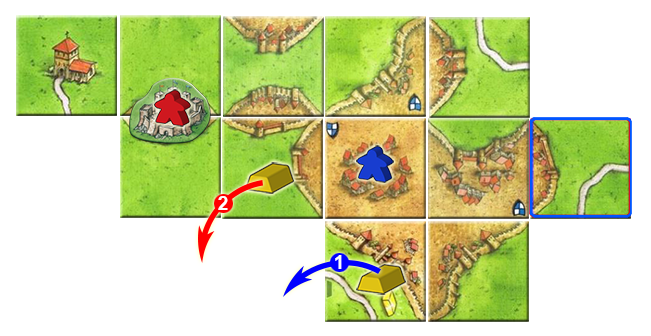 Example 1B-1: BLUE completes their city, which triggers the scoring of the castle occupied by RED. As the active player, BLUE takes a gold piece first and then RED. BLUE was also entitled to the gold piece taken by RED (placed in the castle vicinity and also on one tile of the city controlled by BLUE), and it was RED's only choice in this case, since BLUE took the gold piece at the bottom of the city.
Example 1B-1: BLUE completes their city, which triggers the scoring of the castle occupied by RED. As the active player, BLUE takes a gold piece first and then RED. BLUE was also entitled to the gold piece taken by RED (placed in the castle vicinity and also on one tile of the city controlled by BLUE), and it was RED's only choice in this case, since BLUE took the gold piece at the bottom of the city.
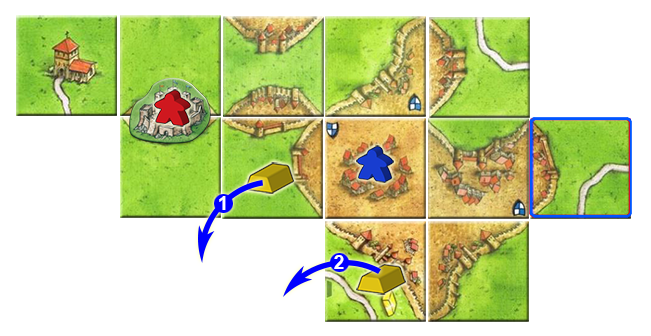 Example 1B-2: BLUE completes their city, which triggers the scoring of the castle occupied by RED. As the active player, BLUE manages to take both gold pieces. BLUE takes the gold piece in the castle vicinity first (both RED and BLUE were entitled to take it), so RED cannot take any gold pieces. Finally, BLUE takes the gold piece at the bottom of the city.
Example 1B-2: BLUE completes their city, which triggers the scoring of the castle occupied by RED. As the active player, BLUE manages to take both gold pieces. BLUE takes the gold piece in the castle vicinity first (both RED and BLUE were entitled to take it), so RED cannot take any gold pieces. Finally, BLUE takes the gold piece at the bottom of the city.
- Exemplul 2: Explorarea celui mai bun rezultat
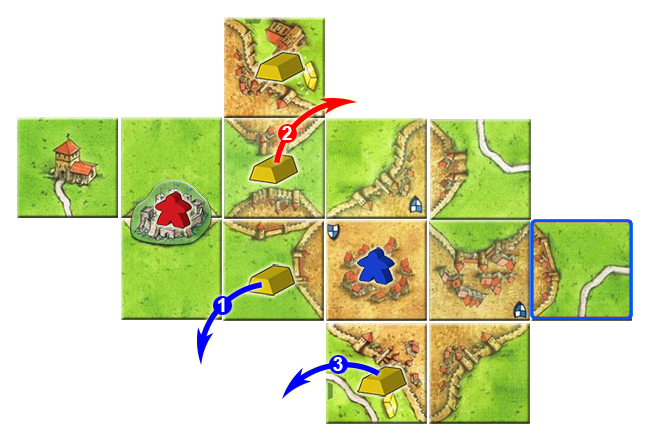 Example 2A: BLUE completes their city, which triggers the scoring of the castle occupied by RED. There are two gold pieces in the castle vicinity, one of them placed on a tile of the city controlled by BLUE). As the active player, BLUE decides to take the gold piece in the castle vicinity which RED is also entitled to, so RED is forced to take the other gold piece in the vicinity. Finally, BLUE takes the gold piece at the bottom of the city.
Example 2A: BLUE completes their city, which triggers the scoring of the castle occupied by RED. There are two gold pieces in the castle vicinity, one of them placed on a tile of the city controlled by BLUE). As the active player, BLUE decides to take the gold piece in the castle vicinity which RED is also entitled to, so RED is forced to take the other gold piece in the vicinity. Finally, BLUE takes the gold piece at the bottom of the city.
BLUE gets 2 gold pieces and RED gets one gold piece.
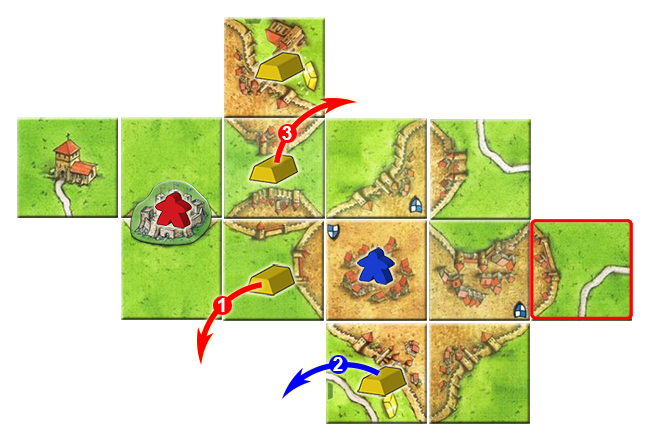 Example 2B: RED completes the city occupied by BLUE, which triggers the scoring of the castle occupied by RED. There are two gold pieces in the castle vicinity, one of them placed on a tile of the city controlled by BLUE). As the active player, RED decides to take the gold piece in the castle vicinity which BLUE is also entitled to, so BLUE is forced to take the gold piece at the bottom of the city. Finally, RED takes the other gold piece in the vicinity.
Example 2B: RED completes the city occupied by BLUE, which triggers the scoring of the castle occupied by RED. There are two gold pieces in the castle vicinity, one of them placed on a tile of the city controlled by BLUE). As the active player, RED decides to take the gold piece in the castle vicinity which BLUE is also entitled to, so BLUE is forced to take the gold piece at the bottom of the city. Finally, RED takes the other gold piece in the vicinity.
BLUE gets 1 gold piece and RED gets 2 gold pieces.
- Exemplul 3: Declanșarea distribuirii de bulgări de aur, dar colectarea niciunuia
- Când se evaluează o cetate, proprietarul său este îndreptățit numai la acei bulgări de aur plasați în vecinătatea cetății, chiar dacă aceștia nu sunt pe cartonașe care aparțin teritoriului ce declanșează evaluarea cetății.
- Exemplul 4: Teritoriile ce declanșează evaluarea sunt irelevante
- Exemplul 5: Secvență implicând construirea unui castel
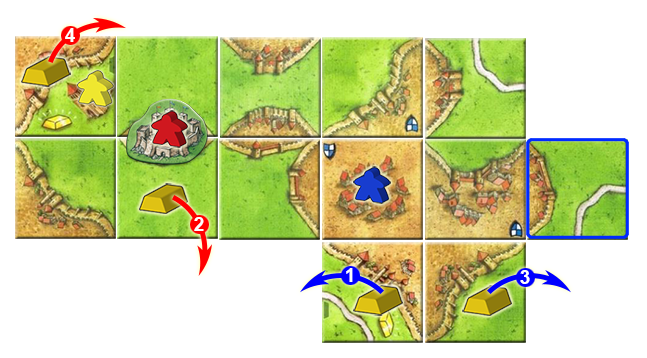 Example 5.4: BLUE completes their city, triggering the scoring of the castle occupied by RED. BLUE and Red will take gold pieces in turns. BLUE will take the two pieces at the bottom of the city and RED will take the two gold pieces in the castle vicinity, no matter the gold pieces are not on the feature triggering the castle scoring.
Example 5.4: BLUE completes their city, triggering the scoring of the castle occupied by RED. BLUE and Red will take gold pieces in turns. BLUE will take the two pieces at the bottom of the city and RED will take the two gold pieces in the castle vicinity, no matter the gold pieces are not on the feature triggering the castle scoring.
- Când este evaluată o mănăstire din vecinătatea cetății, proprietarul său poate lua oricare bulgăre de aur plasat în vecinătatea sa. Cetatea învecinată poate lua în considerare numai acei bulgări de aur din vecinătatea sa de cetate.
- Exemplul 6: Explorarea evaluării unei mănăstiri suprapunându-se vecinătății unei cetăți
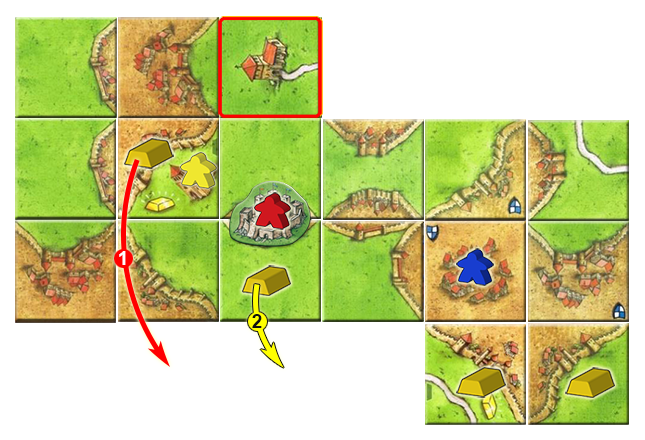 Example 6-1: RED completes the cloister occupied by YELLOW, triggering the scoring of the castle occupied by RED. RED and YELLOW will take one gold piece each, no matter the order they are chosen, since the two gold pieces are both in the castle vicinity and in the vicinity of the cloister (i.e. on the cloister tile or any adjacent tile).
Example 6-1: RED completes the cloister occupied by YELLOW, triggering the scoring of the castle occupied by RED. RED and YELLOW will take one gold piece each, no matter the order they are chosen, since the two gold pieces are both in the castle vicinity and in the vicinity of the cloister (i.e. on the cloister tile or any adjacent tile).
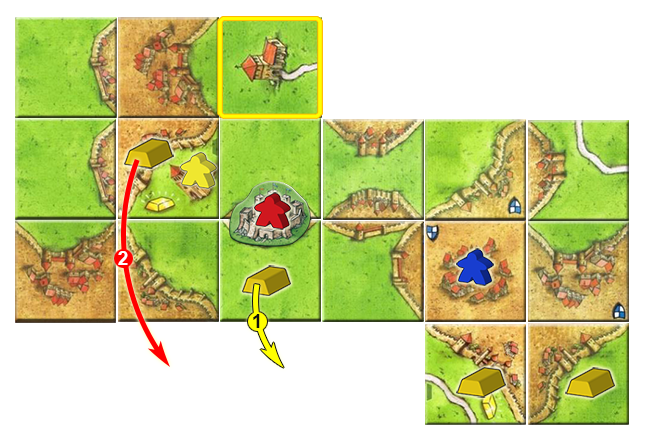 Example 6-2: YELLOW completes their cloister, triggering the scoring of the castle occupied by RED. Yellow and RED will take one gold piece each, no matter the order they are chosen, since the two gold pieces are both in the castle vicinity and in the vicinity of the cloister (i.e. on the cloister tile or any adjacent tile).
Example 6-2: YELLOW completes their cloister, triggering the scoring of the castle occupied by RED. Yellow and RED will take one gold piece each, no matter the order they are chosen, since the two gold pieces are both in the castle vicinity and in the vicinity of the cloister (i.e. on the cloister tile or any adjacent tile).
Adăugirea cercurilor în lan
În fiecare mini, vei găsi un cartonaș din a șaptea miniextensie Cercuri din lanuri. Această extensie este jucabilă cu numai un singur cartonaș, dar este cel mai bine să se joace cu toate cele 6 cartonașe.[8]
Ansamblul cartonașelor
Note de subsol
Pentru licențierea și semnificația pictogramelor te rugăm să vizitezi Pagina pictogramelor.
- ↑
 When a castle is completed, the owner can lay claim to gold pieces in the 6-tile vicinity of the castle: the 2 tiles upon which the castle is built, the 2 tiles to its left, and the 2 tiles to its right. The owner of the castle does not necessarily have the rights to gold associated with the feature that caused completion of the castle (unless that gold is also within the castle's vicinity or the castle owner
also has a majority in the primary feature). (6/2013)
When a castle is completed, the owner can lay claim to gold pieces in the 6-tile vicinity of the castle: the 2 tiles upon which the castle is built, the 2 tiles to its left, and the 2 tiles to its right. The owner of the castle does not necessarily have the rights to gold associated with the feature that caused completion of the castle (unless that gold is also within the castle's vicinity or the castle owner
also has a majority in the primary feature). (6/2013)
- ↑
 In general, any gold pieces on tiles of a completed feature will be distributed while the feature is being scored. Depending on the feature, the gold pieces involved may differ:
In general, any gold pieces on tiles of a completed feature will be distributed while the feature is being scored. Depending on the feature, the gold pieces involved may differ:
- Features distributing gold pieces on their tiles only:
- Roads
- Cities
- Features distributing gold pieces on the feature tile and its adjacent tiles:
- Monastic buildings: cloisters, abbeys, shrines, German monasteries (with a monk), Dutch & Belgian monasteries (with a monk), Japanese buildings (with a monk), Darmstadt churches
- Gardens
- Baba Yaga's hut
- German castles
- Features distributing gold pieces on the feature tile and the road tiles connected to it:
- German cathedrals
- Features distributing gold pieces on the tiles adjacent to the feature:
- Castles
- Features distributing gold pieces on their tiles only:
- ↑
 As a consequence of the rules, gold ingots on the tiles of a completed unclaimed feature will not be distributed, since there is no player controlling the feature.
As a consequence of the rules, gold ingots on the tiles of a completed unclaimed feature will not be distributed, since there is no player controlling the feature.
- ↑
 In general, if one or more features are involved, the active player (if entitled to gold) chooses the first gold piece and can choose any one of the pieces to which he/she may be entitled. The next player (in clockwise order) that is entitled to a gold piece can then choose an appropriate piece. Note that, because a player can choose which piece to take first (if there is more than one to choose from), a different player who may have initially been entitled to a gold piece may miss out if that piece has been claimed before it is that player's turn to choose. (6/2013)
In general, if one or more features are involved, the active player (if entitled to gold) chooses the first gold piece and can choose any one of the pieces to which he/she may be entitled. The next player (in clockwise order) that is entitled to a gold piece can then choose an appropriate piece. Note that, because a player can choose which piece to take first (if there is more than one to choose from), a different player who may have initially been entitled to a gold piece may miss out if that piece has been claimed before it is that player's turn to choose. (6/2013)
- ↑
 The RGG version of the rules states "players who score completed features with gold bars take one gold bar for each feature they score and that has gold bars." This seems different from the HiG rules, where the rule is to only take one gold piece at a time.
The RGG version of the rules states "players who score completed features with gold bars take one gold bar for each feature they score and that has gold bars." This seems different from the HiG rules, where the rule is to only take one gold piece at a time.
- ↑
 This additional rules clarification is from the Big Box 4 edition of the rules.
This additional rules clarification is from the Big Box 4 edition of the rules.
- ↑
 Aceste exemple sunt bazate pe clarificările furnizate de Kettlefish pe următoarele subiecte, conform clarificării furnizate de Christof Tisch din 6/2013.
Aceste exemple sunt bazate pe clarificările furnizate de Kettlefish pe următoarele subiecte, conform clarificării furnizate de Christof Tisch din 6/2013.
- Carcassonne Central: https://www.carcassonnecentral.com/community/index.php?topic=279.0
- Carcassonne Forum: https://www.carcassonne-forum.de/viewtopic.php?f=101&t=886
- ↑
 Remarcă că cartonașele din Cercuri din lanuri incluse în miniextensii sunt diferite de cartonașele lansate în extensia inițială Cercuri în lan (denumită „Cercuri în lan I”).
Remarcă că cartonașele din Cercuri din lanuri incluse în miniextensii sunt diferite de cartonașele lansate în extensia inițială Cercuri în lan (denumită „Cercuri în lan I”).


